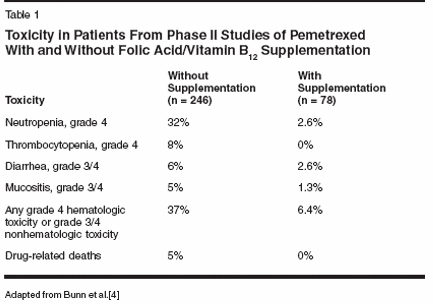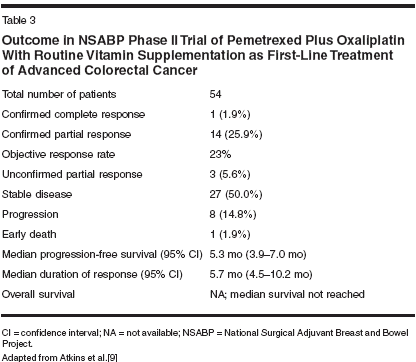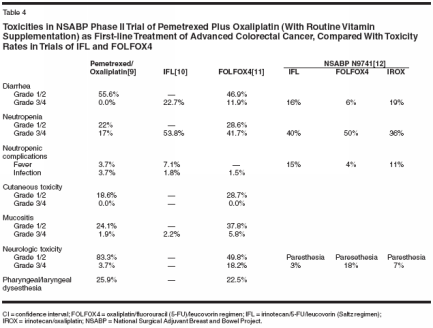Pemetrexed in Advanced Colorectal Cancer
Pemetrexed (Alimta) shows single-agent activity in advancedcolorectal cancer. In two phase II studies in which patients receivedpemetrexed at 600 mg/m2 or 500 mg/m2 as first-line treatment for metastaticdisease, objective response rates were 15.4% and 17.2%.
ABSTRACT: Pemetrexed (Alimta) shows single-agent activity in advancedcolorectal cancer. In two phase II studies in which patients receivedpemetrexed at 600 mg/m2 or 500 mg/m2 as first-line treatment for metastaticdisease, objective response rates were 15.4% and 17.2%. Thesetrials were conducted prior to supplementation with folic acid and vitaminB12, which markedly decreased the frequency of hematologic toxicitiesof pemetrexed; routine supplementation is now included in allclinical trials of the agent. The marked improvement in toxicity andtolerance with vitamin supplementation suggests the need to reexamineoptimal dosing in pemetrexed combination schedules. In a NationalSurgical Adjuvant Breast and Bowel Project phase II trial in 54 patientswith previously untreated advanced colorectal cancer, pemetrexedat 500 mg/m2 plus oxaliplatin (Eloxatin) at 120 mg/m2 every 21 dayswith folic acid/vitamin B12 supplementation resulted in an objective responseof 23%. Three additional patients (5.6%) had unconfirmed partialresponse (partial response at one visit), and 27 patients (50%) hadstable disease. Median progression-free survival was 5.3 months andmedian duration of response was 5.7 months; median overall survivalwas approximately 11.05 months. Grade 3/4 neutropenia was observedin only 17% of patients and treatment was well tolerated. A phase I/IIstudy is under way to identify and assess the optimal combination ofpemetrexed/irinotecan in second-line treatment of advanced colorectalcancer. Planned studies include a phase I study examining the combinationof pemetrexed and oxaliplatin given every 2 weeks as first-linetreatment, and a phase I/II trial to identify the optimal pemetrexed/oxaliplatin dose in a 21-day schedule and to compare pemetrexed/oxaliplatin with FOLFOX4 in first-line treatment of metastatic disease.All of these trials include vitamin supplementation. A phase III trialcomparing the every-3-week pemetrexed/oxaliplatin regimen withFOLFOX4 as first-line treatment will be initiated if the outcome of thephase II trial is encouraging.
Pemetrexed (Alimta) is a multitargetedantifolate agent thatinhibits several enzymes inpyrimidine and purine biosynthesispathways, including thymidylate synthase(TS), dihydrofolate reductase(DHFR), and glycinamide ribonucleotideformyltransferase (GRFT).[1,2]Pemetrexed exhibits single-agent activityagainst a number of solid tumors,including non-small-cell lungcancer, mesothelioma, and pancreas,colorectal, gastric, bladder, breast, andhead and neck cancers.[2]The characteristic toxicities of antifolateagents are well recognized, withthe primary toxicity being myelosuppression.In early studies of pemetrexedperformed without folic acid/vitamin B12 supplementation, the primarytoxicities of pemetrexed weremyelosuppression, skin rash, and mucositis,with neutropenia being the primarydose-limiting toxicity. Analysisof data from patients in pemetrexedphase II studies performed without vitaminsupplementation showed a highlysignificant association of myelosuppressionwith elevated plasma levels ofhomocysteine (> 12 mM)-a sensitivemarker for reduced functional availabilityof folate or vitamin B12.[3]Supplementation with folic acidand vitamin B12 is now routinely includedin pemetrexed treatment in clinical trials. As shown in Table 1,routine supplementation markedly reducesrates of severe hematologic andnonhematologic toxicities.[4] Pemetrexedexhibits good single-agent activityin metastatic colorectal cancerand is being evaluated in combinationwith oxaliplatin (Eloxatin) andirinotecan (Camptosar) in this setting.The improved toxicity and tolerabilityof pemetrexed with vitamin supplementationraises the possibility ofdelivering higher doses than those suggestedby phase I studies performedwithout supplementation.Single-Agent Pemetrexed inMetastatic Colorectal CancerPemetrexed has been evaluated intwo phase II studies in patients withadvanced colorectal cancer.[5,6] Inboth studies, no prior chemotherapyfor metastatic disease was permitted,and adjuvant therapy had to have beencompleted more than 12 months priorto study entry. No vitamin supplementationwas used in either trial.John et al reported data from a USmulticenter trial in which 46 patients(27 male) with a median age of 59years (range: 33 to 86 years) receivedpemetrexed at 600 mg/m2 via 10-minuteintravenous (IV) infusion every 3weeks.[5] Eastern Cooperative OncologyGroup (ECOG) performance status(PS) was 0 in 28 patients, 1 in 11,and 2 in 1, with status unknown in 6.Fifteen patients had received prior adjuvantchemotherapy and eight had receivedprior radiation therapy.Among 39 patients evaluable forresponse, complete response was observedin one patient and partial responsewas observed in five, yieldinga response rate of 15.4%. Median survivalwas 16.2 months, and mediantime to disease progression was 4.4months. Among 41 patients evaluablefor toxicity, hematologic toxicity wasthe most common toxicity, with grade3/4 neutropenia occurring in 56% ofpatients (Table 2).In a Canadian multicenter trial ofCripps et al, 33 patients (17 female)with a median age of 68 years (range:45 to 77 years) received pemetrexedat 600 mg/m2 via 10-minute infusionevery 3 weeks, or at 500 mg/m2 followinga decision to reduce the studydose.[6] ECOG performance statuswas 0 in 13 patients, 1 in 18, and 2 in2. Nine patients had received prioradjuvant therapy and 3 had receivedprior radiation therapy.Among 29 patients evaluable forresponse, complete response occurredin 1 patient and partial response occurredin 4, yielding a response rateof 17.2%. Median survival was 15.1months, and median time to diseaseprogression was 3.3 months. Amongthe 33 patients evaluable for toxicity,hematologic toxicity was the most commontoxicity (Table 2). Grade 3/4 neutropeniaoccurred in 56% of patients atthe 600-mg/m2 dose and in 48% at the500-mg/m2 dose. Dosing at 500 mg/m2was associated with marked reductionsin rates of grade 3/4 thrombocytopenia(4% vs 33%) and anemia (9% vs 22%).




Figure 1(A) shows a comparisonof response rates with pemetrexed inthese phase II studies with responserates observed in relevant phase IIand/or phase III studies with othersingle-agent regimens with activity inmetastatic colorectal cancer (presentedas a cumulative total for comparison).The comparative data suggestthat responses with pemetrexed aresimilar to those with other bolus TSinhibitors. Figure 1(B) compares selectedgrade 3/4 toxicity rates in phaseII studies of pemetrexed in varioussettings that have included routine vitaminsupplementation with toxicityrates reported for the other regimensin phase II and III studies in metastaticcolorectal cancer. Pemetrexed treatmentwith routine vitamin supplementationis associated with an approximately10% rate of grade 3/4neutropenia, and rates of mucositis,diarrhea, and hand-foot syndrome arelower than or similar to rates observedwith the other regimens.Pemetrexed Plus OxaliplatinBoth pemetrexed and oxaliplatinhave shown clinical activity as singleagents in colorectal cancer. The findingof synergistic antitumor effects withthe combination in preclinical models,and the different mechanisms of actionand toxicity patterns of the two agentsmake pemetrexed/oxaliplatin an attractivecombination regimen.

Raymond et al evaluated the antiproliferativepotential of pemetrexedcombined with drugs with known therapeuticactivity against colorectalcancer (ie, fluorouracil [5-FU], oxaliplatin,and the active metabolite ofirinotecan SN38).[7] The activity ofsingle-agent pemetrexed or combinationswith one the three agents wasassessed in parental human HT29 colorectalcancer lines and in 5-FU-resistantHT29-5FU cells, with eithersimultaneous or sequential administration.(Median-effect plot analysisexpressed the possible functional interactionbetween the agents.)Figure 2 shows results of simultaneousor sequential exposure of humanHT29 and 5-FU-resistant HT29colorectal cancer tumor cells to pemetrexedand oxaliplatin. Results showclear synergy, indicated by a combinationindex < 1, when the drugs areadministered together. The drug combinationsand sequence with optimaleffects were also evaluated in athymicmice bearing human HT29 tumorcell xenografts. Figure 3 illustratesresults using the agents aloneor in combination compared with controlsin human HT29 xenografts, indicatinga superior effect in delayingtumor growth with the combination.Misset et al conducted a phase Istudy (without vitamin supplementation)in 36 patients with metastaticsolid tumors who received pemetrexedat an initial dose of 300 mg/m2by 10-minute infusion followed byoxaliplatin at an initial dose of 85mg/m2 via 2-hour infusion on day 1every 21 days.[8] The combinationwas given at six dose levels up topemetrexed at 500 mg/m2 and oxaliplatinat 130 mg/m2. Of 45 patientsenrolled, 36 were evaluable for toxicityand response.Dose-limiting toxicities occurredin 5 patients out of 16 at the pemetrexedat 500 mg/m2 plus oxaliplatinat 130 mg/m2 dose level, with thedose-limiting toxicities consisting ofgrade 3/4 diarrhea in two patients,grade 3/4 febrile neutropenia in two,grade 3 paresthesias in one; there wasone toxic death. The maximum tolerateddose was thought to be pemetrexedat 500 mg/m2 and oxaliplatin at130 mg/m2. Five responses (all partial)were reported over a broad rangeof solid tumors. The recommendedregimen without vitamins for phase IIstudies was pemetrexed at 500 mg/m2plus oxaliplatin at 120 mg/m2.In a phase II trial performed byAtkins et al and the National SurgicalAdjuvant Breast and Bowel Project(NSABP) foundation research program,54 patients with previouslyuntreated stage IV colorectal cancerwere treated with pemetrexed at 500mg/m2 plus oxaliplatin at 120 mg/m2every 21 days with folic acid/vitaminB12 supplementation throughout thecourse of study treatment.[9] In the absenceof progressive disease, treatmentwas to continue for at least six cycles,and could be continued at the discretionof the investigator until diseaseprogression or unacceptable toxicityoccurred.Patients had a median age of 60years (range: 33 to 80 years), 30(55.6%) were male, and 45 (83.3%)had colon cancer and 9 (16.7%) hadrectal cancer. ECOG PS was 0 in 30patients (55.6%) and 1 or 2 in 24(44.4%). Two patients (3.7%) had receivedprior radiation therapy and 16(29.6%) had received prior chemotherapy.(However, no prior chemotherapyfor advanced disease and noadjuvant chemotherapy within 6months were allowed.) Tumor sitesconsisted of the liver alone in 22 patients(40.7%), the liver and an additionalsite in 22 (40.7%), and othersites in 10 (18.5%). Patients receiveda median of six treatment cycles(mean: 6.35 cycles).A total of 54 patients were evaluablefor toxicity and 47 for response.The confirmed objective response ratewas 23% (Table 3). Three additionalpatients (5.6%) had unconfirmed partialresponse (partial response at onevisit); 27 patients (50%) had stable disease.Early death occurred in one patient,who died unexpectedly at homeafter the first treatment cycle. Medianprogression-free survival was 5.3months and median duration of responsewas 5.7 months. Overall survivalwas approximately 11.05 months.Table 4 shows rates of grade 1/2and grade 3/4 diarrhea, neutropenia,neutropenic complications, cutaneoustoxicity, mucositis, neurologic toxicity,and pharyngeal/laryngeal dyses-thesias in this trial and reported ratesof these toxicities from phase III trialsof the IFL (irinotecan plus 5-FU/leucovorin)regimen [10] and the FOLFOX4(oxaliplatin plus 5-FU/leucovorin) regimen reported by deGramont and colleagues[11] in advancedcolorectal cancer.Also included in Table 4 for comparisonare grade 3/4 toxicities ratesfrom the NSABP N9741 phase IIItrial of Goldberg et al, who comparedIFL, FOLFOX4, and irinotecan/oxaliplatin(IROX) as first-line treatmentin patients with advanced disease.[12]As can be seen, the pemetrexed/oxaliplatincombination with vitaminsupplementation resulted in no grade3/4 diarrhea and a notably low rate ofgrade 3/4 neutropenia. Other grade 3/4 toxicities consisted of fatigue(13.0%), thrombocytopenia (11.1%),hyperglycemia (11.1%), nausea(9.3%), anemia (7.5%), thrombosis/embolism (5.6%), vomiting (3.7%),and allergic reactions (1.9%). Thesefindings suggest the potential for usinghigher doses of pemetrexed incombination with oxaliplatin whenroutine vitamin supplementation isprovided, with the possibility of optimizingtherapeutic response.


Pemetrexed Plus IrinotecanIn a phase I trial of the combinationof pemetrexed and irinotecan performedwithout vitamin supplementation,pemetrexed was given via10-minute infusion at an initial doseof 300 mg/m2 on day 1 and irinotecanwas given via 90-minute infusion atan initial dose of 175 mg/m2 on day 1every 21 days. The dose suggestedfor phase II study in patients withadvanced or metastatic colorectal cancerwas pemetrexed at 400 mg/m2 andirinotecan at 250 mg/m2.[13,14]Kroening et al further conducted aphase I dose-escalation trial (of thephase II amendment) in 12 patients inthe second-line setting (with vitaminsupplementation). The authors reportedthat the combination of pemetrexedat 500 mg/m2 plus irinotecan at 300mg/m2 was well tolerated and selectedfor a phase II trial in second-line colorectalcancer in patients with locallyadvanced or metastatic disease.[14]However, given the findings onimproved toxicity with vitamin supplementation,a new phase I/II studyhas been undertaken. This US andEuropean multicenter trial is enrollingpatients who have had one priorcourse of chemotherapy for metastaticcolorectal cancer but no prior exposureto irinotecan. All patients areto receive folic acid and vitamin B12supplementation. The initial dose inthe phase I portion of the study ispemetrexed at 300 mg/m2 plus irinotecanat 175 mg/m2 on day 1 every 3weeks. Thus far, minimal toxicity hasbeen observed in the first 20 patientsenrolled.ConclusionPemetrexed is active as a singleagent in first-line treatment of advancedcolorectal cancer. Administrationof folic acid and vitamin B12with pemetrexed markedly reduceshematologic and other toxicities; alltrials of pemetrexed now include routinevitamin supplementation. Pemetrexedhas a convenient administrationschedule and can be safely administeredin combination with a full single-agent dose of oxaliplatin. Thepemetrexed/oxaliplatin combination isactive and well tolerated in patientswith metastatic colorectal cancer. Ongoingand planned studies will helpdetermine optimal schedules for pemetrexedin combination with oxaliplatinand irinotecan.In addition to the ongoing phase I/II study of pemetrexed/irinotecan insecond-line treatment, a phase I studyis planned to examine the combinationof pemetrexed and oxaliplatin givenevery 2 weeks as first-linetreatment, and a phase I/II trial isplanned to identify the optimal pemetrexed/oxaliplatin dose in a 21-dayschedule with vitamin supplementationand to compare pemetrexed/oxaliplatinwith FOLFOX4 inrandomized fashion in first-line treatmentof metastatic disease. Pendingthe outcome of the randomized phaseII portion of the latter trial is the initiationof a planned phase III trial comparingthe 3-week pemetrexed/oxaliplatin regimen with FOLFOX4as first-line treatment.
Disclosures:
The authors have nosignificant financial interest or other relationshipwith the manufacturers of any productsor providers of any service mentioned in thisarticle.
References:
1.
Shih C, Chen VJ, Gossett LS, et al:LY231514, a pyrrolo[2,3-d]pyrimidine-basedantifolate that inhibits multiple folate-requiringenzymes. Cancer Res 57:1116-1123, 1997.
2.
Hanauske AR, Chen V, Paoletti P, et al:Pemetrexed disodium: A novel antifolate clinicallyactive against multiple solid tumors. Oncologist6:363-373, 2001.
3.
Niyikiza C, Baker SD, Seitz DE, et al:Homocysteine and methylmalonic acid: Markersto predict and avoid toxicity frompemetrexed therapy. Mol Cancer Ther 1:545-552, 2002.
4.
Bunn P, Paoletti P, Niyikiza C, et al: VitaminB12 and folate reduce toxicity of Alimta(pemetrexed disodium, LY231514, MTA), anovel antifolate/antimetabolite (abstract 300).Proc Am Soc Clin Oncol 20:76a, 2001.
5.
John W, Picus J, Blanke CD, et al: Activityof multitargeted antifolate (pemetrexed disodium,LY231514) in patients with advancedcolorectal carcinoma: Results from a phase IIstudy. Cancer 88:1807-1813, 2000.
6.
Cripps C, Burnell M, Jolivet J, et al: PhaseII study of first-line LY231514 (multi-targetedantifolate) in patients with locally advanced ormetastatic colorectal cancer: An NCIC ClinicalTrials Group study. Ann Oncol 10:1175-1179, 1999.
7.
Raymond E, Louvet C, Tournigand C, etal: Pemetrexed disodium combined withoxaliplatin, SN38, or 5-fluorouracil, based onthe quantitation of drug interactions in humanHT29 colon cancer cells. Int J Oncol 21:361-367, 2002.
8.
Misset JL, Gamelin E, Campone M, et al:Phase I and pharmacokinetic study of themultitargeted antifolate pemetrexed in combinationwith oxaliplatin in patients with advancedsolid tumors. Ann Oncol 15:1123-1129,2004.
9.
Atkins JN, Jacobs S, Wieand S, et al:Pemetrexed and oxaliplatin for first-line treatmentof patients with advanced colorectal cancer:A phase II trial of the NSABP foundationresearch program (abstract 1108). Proc Am SocClin Oncol 22:276, 2003.
10.
Saltz LB, Cox JV, Blanke C, et al:Irinotecan plus fluorouracil and leucovorin formetastatic colorectal cancer. Irinotecan StudyGroup. N Engl J Med 343:905-914, 2000.
11.
de Gramont A, Figer A, Seymour M etal: Leucovorin and fluorouracil with or withoutoxaliplatin as first-line treatment in advancedcolorectal carcinoma. J Clin Oncol18:2938-2947, 2000.
12.
Goldberg RM, Sargent DJ, Morton RF,et al: A randomized controlled trial of fluorouracilplus leucovorin, irinotecan, and oxaliplatincombinations in patients with previously untreatedmetastatic colorectal cancer. J ClinOncol 22:23-30, 2004.
13.
Hochster H: The role of pemetrexed inthe treatment of colorectal cancer. Semin Oncol29(6 suppl 18):54-6, 2002.
14.
Kroening H, Hochster H, Grothey A, etal: Pemetrexed and irinotecan as second-linetherapy for locally advanced or metastaticcolorectal cancer: A phase I dose escalationstudy (abstract 1459). Proc Am Soc Clin Oncol22:363, 2003.